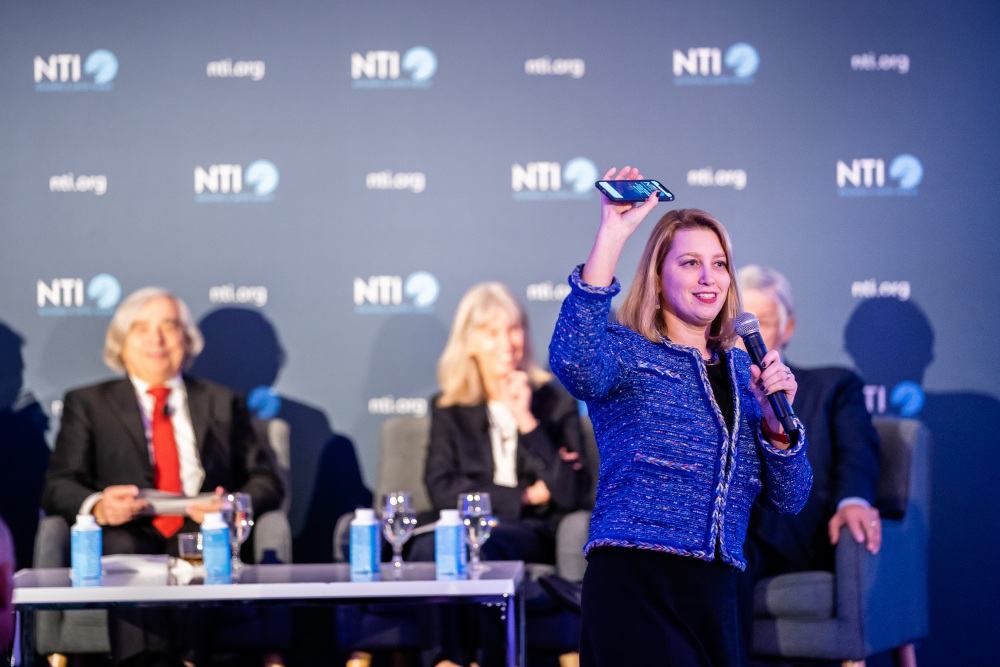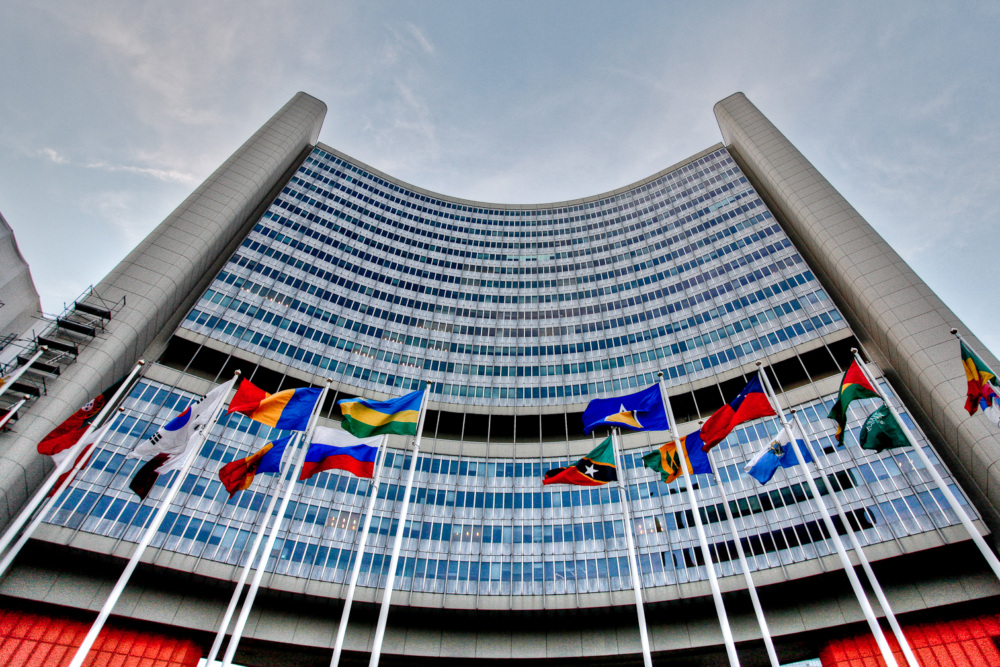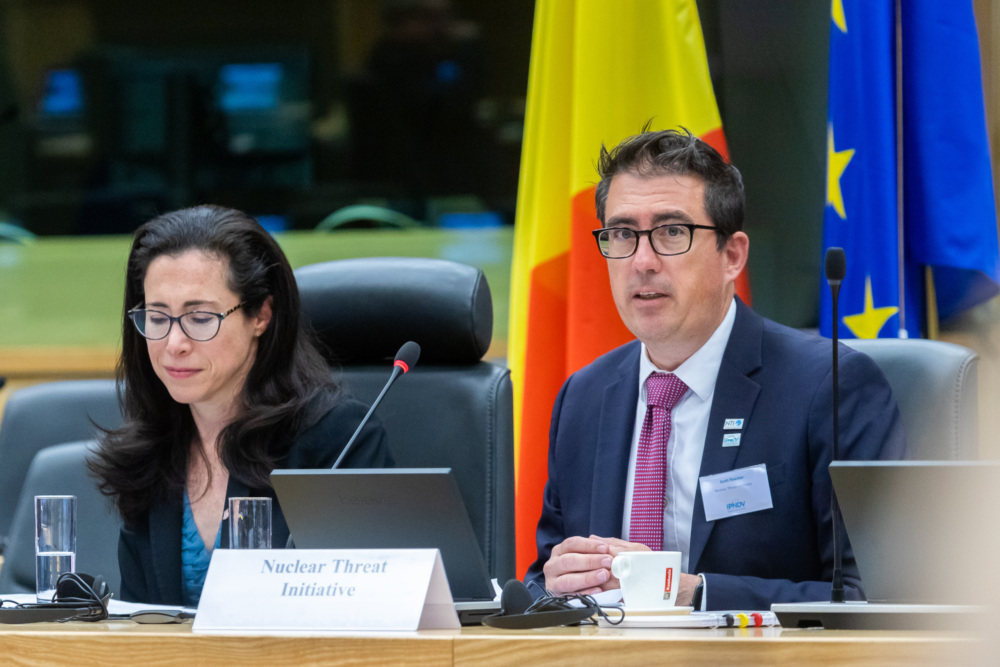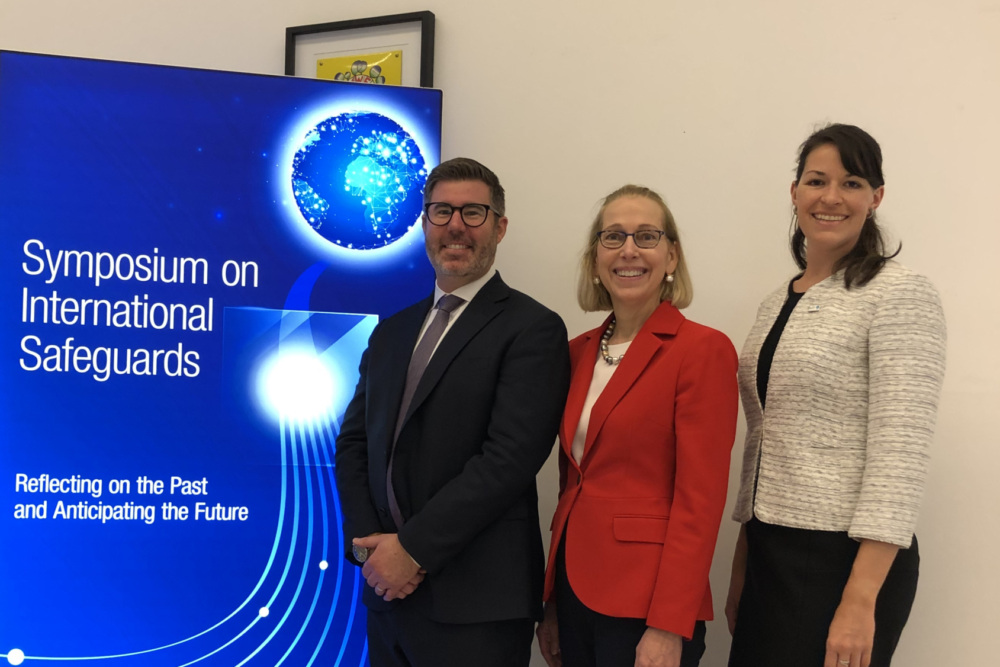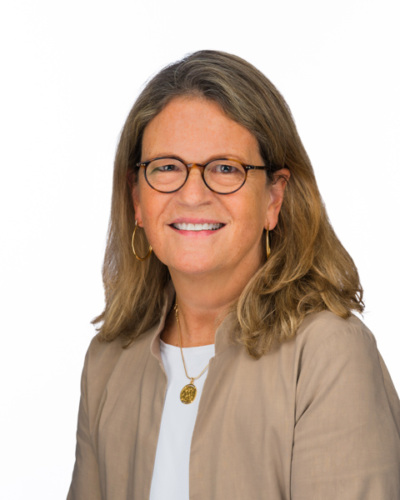
Mimi Hall
Vice President, Communications
Atomic Pulse
Corey Hinderstein joined NTI in 2006 as a “director for special projects,” with an immediate responsibility for helping to create the World Institute for Nuclear Security. Today, as vice president for International Fuel Cycle Strategies, she brings her deep expertise in international nuclear fuel cycle policy, improving global nuclear security, and arms control and nonproliferation to NTI, as well as experience gained during a three-year stint at the Department of Energy’s (DOE) National Nuclear Security Administration from 2015-2017.
Over the course of this year, as NTI marks its 20th anniversary, our experts will share some reflections on two decades of working to build a safer world—accomplishments and challenges, lessons learned along the way, visions for the future, and more. Today, we hear from Hinderstein, whose wealth of experience includes helping to implement the Iran nuclear deal, serving as a “yak” at the 2016 Nuclear Security Summit, and traveling to North Korea.
You have been deeply involved in so many of NTI’s key projects over the years, but let’s start with WINS, the World Institute for Nuclear Security. You were brought on board early on to help with the creation of this new institute. What was it all about?
I was hired in 2006 when NTI was just five years old, and in those early years, the organization had been focused mainly on Russia and the former Soviet Union space. As senior vice president, Joan Rohlfing had responsibility for the whole rest of the world, and she recruited me to work on nuclear security globally.
NTI recognized that there was no organization that focused exclusively on global nuclear security. In the years following 9/11, the whole nuclear policy community recognized that nuclear security should be a higher priority and that there was a need for greater focus, but there was a gap between the practitioners and the policymakers, between the day-to-day work and the big picture.
There were, of course, a couple of nuclear security-related treaties in effect at the time, but for the people whose job it was every day to perform robust nuclear security at facilities, at plants, at labs, and at universities, there was no way to collect their knowledge, identify good practices, and share them more broadly with others as the world was going through an evolution in nuclear security.
Before I joined NTI, Joan had led a number of activities to determine if an organization like WINS could fill that gap. That effort involved workshops in Prague in 2004 and, in particular, a partnership with the Institute of Nuclear Materials Management (INMM), a professional society in the field. Building the partnership with the INMM and the Department of Energy, engaging the leadership at the International Atomic Energy Agency (IAEA) as a partner rather than a competitor was so important. Our goal was to complement and supplement what was already going on but not duplicate. We tested different ideas, did some international data gathering, and brought people together to say, “If this organization existed, how would you engage with it?” We also did some pilot project testing, and, through those activities, we demonstrated that WINS was an idea whose time had come and it could be an important new piece of the international nuclear security architecture.
So, it is now more than 10 years since WINS stood up. Is it what you envisioned it could be?
I don’t know if I could have expected it, but I certainly hoped for it. WINS now has about 5,000 members from more than 140 countries and runs a rigorous training course for practitioners through the WINS Academy. And although we launched the organization, and Charlie Curtis served as chair of its board from 2008-2012, NTI has not been a primary funder since our very first founding grant in 2008, and they get funding from countries and foundations. They have a professional staff, and they’ve just gone through their first leadership transition from the founding executive director, Roger Howsley, who really helped build the organization, to the new executive director, Lars van Dassen. They have transitioned from being an international association to an international non-governmental organization that stands on its own two feet and has been validated through the participation of its members and its partnerships.
You also were very involved—along with Charlie Curtis, Laura Holgate, and many others at NTI—in the development of a Low-Enriched Uranium Fuel Bank (LEU Bank) in Kazakhstan. How the LEU Bank came together is a remarkable story that, as our CEO Ernie Moniz has said, in many ways exemplifies what NTI does best: develop ambitious ideas, build international coalitions, and facilitate action on a large scale. Can you share some highlights from that work – and how the bank contributes to global nonproliferation efforts?
The LEU Bank is really an interesting project and it’s a perfect example of how NTI took an existing idea and brought it to life. People have talked about the concept of fuel banks for decades really, and there have been different initiatives over time to try to explore that idea. The main motivation has always been concerns about the production of fuel for the commercial nuclear industry. From a national security perspective, the most sensitive and potentially dangerous element of that is uranium enrichment because it’s the same technical process, whether you’re making fuel for a nuclear power reactor or targets for medical isotope production or a bomb.
We really worry about the spread of uranium enrichment technology around the world. A lot of measures have been put in place to try to discourage, dissuade, and, frankly, prevent and disrupt the spread of uranium enrichment technology. But at the same time, the use of nuclear energy for peaceful purposes remains valuable and important for the future, whether it’s for nuclear electricity as we look towards lower carbon emissions, or medical and industrial uses. So, we had to ask ourselves: how can we empower something that supports the commercial and peaceful use of nuclear energy but doesn't increase the risks of nuclear proliferation or the spread of nuclear weapons even further?
The only thing that made sense to us was establishing a reserve of enriched uranium that would be under international control and not under the thumb of any particular country. And I say that because there actually are LEU banks out there that the United States and Russia have created. But if you’re somebody who gets their fuel from the United States or from Russia directly, and you had your fuel supply cut off during a dispute or for some other reason, would you really rely on that assurance? So, the key thing for us was to help establish something that was truly under international control, and that’s where the idea for the IAEA LEU Bank came from. It was to have a last resort option for states who really have peaceful uses in mind
This is another example of one of the things NTI does best. We bring together partners and generate cooperation between governments and international organizations.
Right. It is not enough just to have a good idea. That’s where NTI is different. Lots of people have really great ideas. The key is, NTI was in a position to have a strategic partnership with a donor, in this case Warren Buffett, to put the first seed money forward, and then to have the leverage to build a consortium of over 30 countries that were donors to the LEU Bank. A number of those came through European Union contribution, but then the United States, Norway, Kuwait, and United Arab Emirates donated individually as well.
We also were able to work with the IAEA and their professional staff to make sure they had what they needed to move the idea forward through their system, and then the last piece was that the bank has to sit somewhere and NTI has had a strategic relationship over the years with Kazakhstan, clearly related to Kazakhstan’s strong record on non-proliferation and disarmament.
The International Partnership for Nuclear Disarmament Verification (IPNDV) is another major international project now on your plate. The IPNDV is a public-private partnership between NTI, the U.S. Department of State, and more than 25 countries. There aren’t any major new nuclear disarmament treaties on the horizon right now. Why do we need this program?
One of the things that was so exciting about IPNDV is that when we started looking at verification and monitoring for a world without nuclear weapons, it was an activity that was related to the vision and the steps—the work of Schultz, Perry, Kissinger, and Nunn. They always said, and I truly believe, that you can't just snap your fingers and eliminate nuclear weapons. That doesn't leave us safer.
The idea of moving towards fewer or no nuclear weapons is to do it in a way where we’re safer at the end of that process. And verification is one of the steps in that process, so we decided to work on developing the concepts that would support that, in particular, the process of dismantling nuclear weapons is a key step that we just didn’t have the answer to.
When we started working on verification, we brought together international experts and issued a series of reports that came out of what we called the “Verification Pilot Project.” One of the big “aha” moments that we had was that not only is there a need to work on verification now before we need to use it, but we learned that we needed to bring more intellectual resources to bear than just those from nuclear weapon states. The idea of actually opening this conversation to a broader group of non-nuclear weapon states was not obvious—and it’s not uncontroversial—but we felt it was crucial to the process.
The fact is, verification of nuclear weapons dismantlement is not the purview of just those who know about nuclear weapons. There are a whole lot of other technical and procedural and statistical and other kinds of concepts that are relevant, so we lose out if we don’t take advantage of all the brainpower that we have available to us.
The Verification Pilot Project had one overarching recommendation in the longer list of very specific ones and that was that we need to have a truly international collaborative effort to move these concepts forward. What was really exciting was that the State Department saw that recommendation and agreed and said that they wanted to try to build that coalition. And that's what turned into IPNDV, a joint effort co-led by the State Department and NTI to lay a solid foundation for further reductions in nuclear weapons.
We’re now on year seven of the partnership, working through multiple administrations and with more than 25 countries. It’s a cutting-edge project, and it’s really, really exciting.
You took a leave from NTI for three years to work at the Department of Energy’s National Nuclear Security Administration (NNSA). A couple of other NTI staff members also have taken time to work in government and then returned. Did that experience help shape your work here at NTI?
Absolutely, it did. I left NTI in early 2015 for a great opportunity, and it was an opportunity that I think I really needed at the time. You know, we all have those moments where we need a bit of a refresh and a little change. The opportunity allowed me to go to NNSA and bring my perspective, having spent my entire career in civil society, on what issues matter and how people talk about them. What are effective ways of engaging a lot of different communities that, when you work every day in government, you don’t have time to think about, much less execute?
I think it’s important to note that the mechanism through which I went into government completely barred me from having any engagement with NTI while I was there, appropriately so. But after three years, I could come back to NTI and bring that perspective on how NTI could be more effective, how we could shape our good ideas in ways that they could actually have uptake in government. How we could think about the constraints that government is working under and make sure that if we were coming up with an idea, we weren’t offering something undigestible but something that can be put to good use.
Unfortunately, the program hasn’t been used by most NGOs. It’s much more often used by the national laboratories or universities, and it’s too bad because it’s an opportunity that really is a win-win. When I went in, I was particularly excited because I was able to support the Department of Energy’s participation in the Nuclear Security Summit of 2016. So, the first thing I got to do was spend 18 months on an issue that I knew very well from working outside it, and I got an extremely different view from inside. I saw the Department of Energy’s contribution to the summit as being particularly meaningful, and I was happy to play a part in that.
Sign up for our newsletter to get the latest on nuclear and biological threats.
Governments should use the 2024 International Conference on Nuclear Security (ICONS) to reaffirm their commitment to preventing nuclear catastrophe.
Scott Roecker, vice president of the Nuclear Materials Security team, sat down with NTI's Mary Fulham for the latest in Atomic Pulse's "Get to Know NTI" series.
NTI played a prominent role in this year’s IAEA Symposium on International Safeguards. Learn more about our what our experts were up to through this photo blog.
